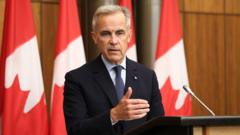Canada is moving to reduce tensions in trade relations with the U.S. by withdrawing some retaliatory tariffs, though significant levies on crucial sectors remain intact.
Canada Eases Trade Tensions by Dropping Select Tariffs on US Goods

Canada Eases Trade Tensions by Dropping Select Tariffs on US Goods
Prime Minister Carney announces reductions while maintaining key tariffs on certain imports.
In a significant shift aimed at improving trade relations, Canada has announced plans to drop some of its retaliatory tariffs on American goods. Prime Minister Mark Carney declared the changes will take effect on September 1, allowing for freer trade across a range of products while maintaining levies on automobiles, steel, and aluminum.
Previously, Canada had imposed a hefty 25% tariff on approximately C$30 billion ($21.7 billion) worth of U.S. goods, affecting various products from orange juice to washing machines. This retaliation was prompted by U.S. tariffs that, as of August 2023, stood at 35% on goods that did not comply with the existing free trade agreement between the two countries.
Carney noted that this decision is designed to align Canada with the U.S. by removing tariffs on goods compliant with the U.S.-Mexico-Canada Agreement (USMCA). This strategic move aims to "re-establish free trade for the vast majority" of goods exchanged between Canada and the United States, promoting a strengthened bilateral relationship.
The White House welcomed Canada’s decision, calling it “long overdue” and indicating an eagerness to continue strategic discussions regarding trade and national security. Public sentiment in Canada appears to support the measure; polls indicate that many citizens back retaliatory tariffs against the U.S., providing Carney with a mandate to negotiate more aggressively.
Despite the eased tariffs, the Canadian government will continue to uphold its 25% tariffs on American steel, aluminum, and automobile imports, indicating a cautious balancing act between driving trade and protecting domestic industries. Carney emphasized the need to preserve Canada’s advantageous tariff position, which currently stands at an average tariff rate of 5.6% on goods with compliant trade agreements, significantly lower than the roughly 16% average rate for other countries.
As a next step, negotiations will focus on resolving outstanding issues related to steel, aluminum, and lumber, in preparation for an upcoming review of the USMCA agreement next year. Since President Trump assumed office, the U.S. has been involved in a global trade conflict, implementing tariffs on goods worldwide, with rising tensions being a catalyst for Canada’s recent adjustments.
Previously, Canada had imposed a hefty 25% tariff on approximately C$30 billion ($21.7 billion) worth of U.S. goods, affecting various products from orange juice to washing machines. This retaliation was prompted by U.S. tariffs that, as of August 2023, stood at 35% on goods that did not comply with the existing free trade agreement between the two countries.
Carney noted that this decision is designed to align Canada with the U.S. by removing tariffs on goods compliant with the U.S.-Mexico-Canada Agreement (USMCA). This strategic move aims to "re-establish free trade for the vast majority" of goods exchanged between Canada and the United States, promoting a strengthened bilateral relationship.
The White House welcomed Canada’s decision, calling it “long overdue” and indicating an eagerness to continue strategic discussions regarding trade and national security. Public sentiment in Canada appears to support the measure; polls indicate that many citizens back retaliatory tariffs against the U.S., providing Carney with a mandate to negotiate more aggressively.
Despite the eased tariffs, the Canadian government will continue to uphold its 25% tariffs on American steel, aluminum, and automobile imports, indicating a cautious balancing act between driving trade and protecting domestic industries. Carney emphasized the need to preserve Canada’s advantageous tariff position, which currently stands at an average tariff rate of 5.6% on goods with compliant trade agreements, significantly lower than the roughly 16% average rate for other countries.
As a next step, negotiations will focus on resolving outstanding issues related to steel, aluminum, and lumber, in preparation for an upcoming review of the USMCA agreement next year. Since President Trump assumed office, the U.S. has been involved in a global trade conflict, implementing tariffs on goods worldwide, with rising tensions being a catalyst for Canada’s recent adjustments.




















